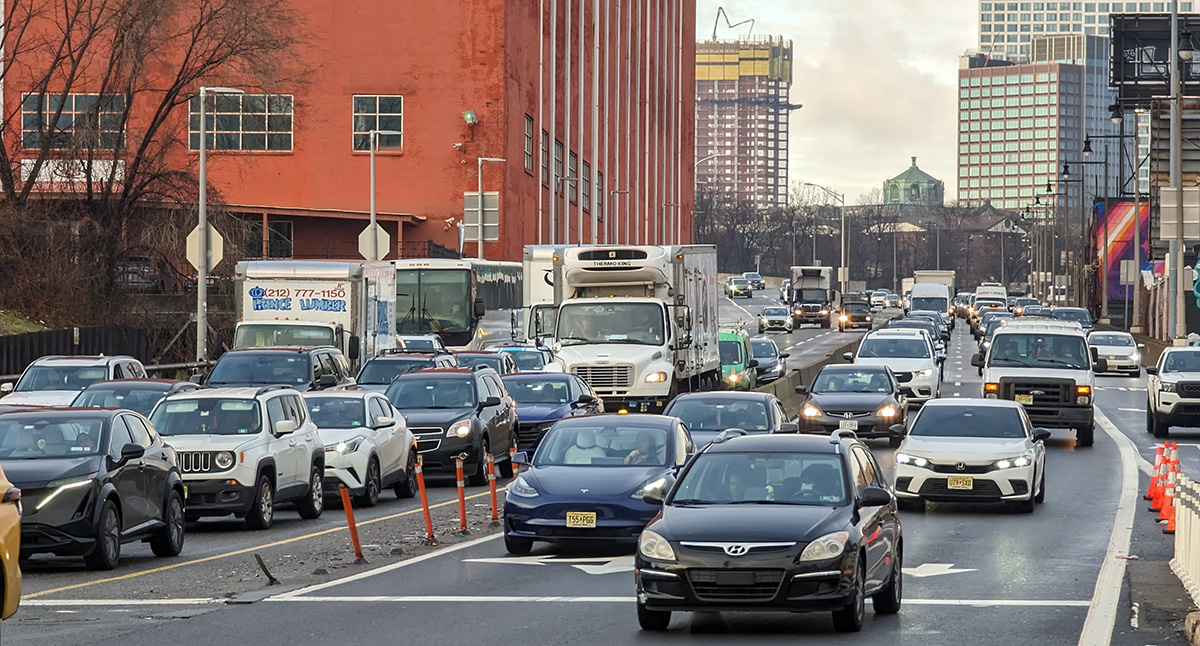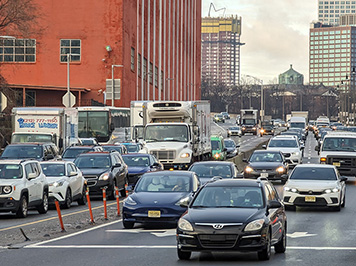Despite fierce debate for over 20 years, congestion pricing has finally been implemented in New York City.

New Jersey traffic headed to the entrance of the Holland Tunnel.
By Jennifer Mynard | January 16, 2025
Despite fierce debate for over 20 years, congestion pricing has finally been implemented in New York City. The program which debuted on January 5, 2025, seeks to de-incentivise overcrowding during peak traffic hours while decreasing emissions and raising sorely needed funds for public transportation across the city. The toll applies to vehicles within the Central Business District (CBD) or “Congestion Relief Zone” (CRZ) which encompasses all streets below 60th except for the highways bordering the water.
Although the program began less than two weeks ago, the MTA has already declared the plan a success after one week of positive data. Overall, the MTA found a 7.51% reduction in traffic within the CBD as compared to averages from this time last year. The reduction has led to decreases in commute times via bridges and tunnels with the greatest enhancements coming from inbound river crossings during morning peak travel time. The most notable example can be found at the Holland Tunnel which experienced a 65% drop in travel time from an average 12 minutes and 48 seconds to 4 minutes and 27 seconds during rush-hour. Time to travel inside the city on east-west and north-south streets also decreased.
The original plan called for a starting fee of $15 per personal vehicle, but opponents of the program argued it down to $9. The Metropolitan Transportation Authority (MTA) plans to slowly increase the toll to $15 by 2031. One of the most publicized challenges to the program came from New Jersey Governor Phil Murphy who felt the program unfairly burdened NJ commuters. Although New York Governor Kathy Hochul offered New Jersey a cut of the proceeds, Murphy declined. Friday night, a federal court judge denied the State of New Jersey suit challenging the Federal Highway Administration approval of the congestion pricing plan.
Citizens have taken to social media forums and dinner party conversation to express their concerns and excitement about the plan so far. People who already depend on public transportation appreciate the decrease in bus commute time but dislike how crowded it has become. They worry that the system may not have the capacity to handle the influx of people who previously drove, especially when the PATH trains are scheduled to close for nearly all of February. Drivers who have converted to public transportation to avoid the fee are disgruntled while those who still drive are enjoying shorter drive times.
Pedestrians are finding it safer and easier to walk across the typically daunting avenues of The Big Apple. Traffic directors love not having to wrangle a deluge of cars trying to disregard painted lines in favor of a last-minute merge. Some argue that the traffic hasn’t decreased but is instead displaced.. The negative range of reactions were anticipated but are unlikely to be ameliorated in the near future. Complaints about the limits of public transportation can’t be addressed until funding from the program begins to accumulate.
The initial data released by the MTA may look positive, but still faces political opposition, most notably from President-Elect Donald Trump who has vowed to kill the program when he takes office on January 20. As the first policy of its kind in the United States, the outcome will set a precedent for any other pilot projects. Its success could inspire other major cities to follow suit. Successful congestion pricing around the world has been established in London, Stockholm, and Singapore but only after initial backlash and continuous revision. NYC’s fledgling program has the potential to improve the entire transportation ecosystem surrounding Manhattan, decrease emissions, improve pedestrian and biking experiences, decrease reliance on personal vehicles, and move the US in a greener direction. But these outcomes are only possible if we give it time to take shape and adapt.
Related Links
New Jersey environmental and civic groups challenge Governor Murphy’s opposition to NYC’s congestion pricing plan
Fierce opposition to $4.7 billion expansion of Turnpike Extension meets resistance from NJ Governor and Turnpike Authority
The Battle for a Protected Bike Lane on JFK Boulevard East


